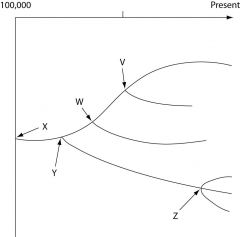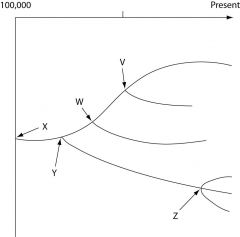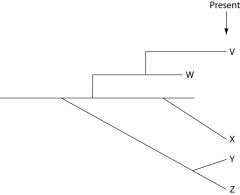![]()
![]()
![]()
Use LEFT and RIGHT arrow keys to navigate between flashcards;
Use UP and DOWN arrow keys to flip the card;
H to show hint;
A reads text to speech;
57 Cards in this Set
- Front
- Back
|
Darwin and Wallace's theory of evolution by natural selection was revolutionary because it _____. |
dismissed the idea that species are constant and emphasized the importance of variation and change in populations
|
|
|
Catastrophism was Cuvier's attempt to explain the existence of _____.
|
the fossil record
|
|
|
With what other idea of his time was Cuvier's theory of catastrophism most in conflict?
|
uniformitarianism
|
|
|
Prior to the work of Lyell and Darwin, the prevailing belief was that Earth is _____. |
a few thousand years old, and populations are unchanging
|
|
|
During a study session about evolution, one of your fellow students remarks, "The giraffe stretched its neck while reaching for higher leaves; its offspring inherited longer necks as a result." Which statement is most likely to be helpful in correcting this student's misconception?
|
Characteristics acquired during an organism's life are generally not passed on through genes.
|
|
|
When Cuvier considered the fossils found in the vicinity of Paris, he concluded that the extinction of species _____.
|
occurs, but that there is no evolution
|
|
|
In the mid-1900s, the Soviet geneticist Lysenko believed that his winter wheat plants, exposed to increasingly colder temperatures, would eventually give rise to more cold-tolerant winter wheat. Lysenko's attempts in this regard were most in agreement with the ideas of _____.
|
Lamarck
|
|

The following questions refer to the figure below, which shows an outcrop of sedimentary rock whose strata are labeled A-D. If x indicates the location of fossils of two closely related species, then fossils of their most-recent common ancestor are most likely to occur in which stratum? |
C |
|
|
If x indicates the fossils of two closely related species, neither of which is extinct, then their remains may be found in how many of these strata? |
two strata
|
|

The following questions refer to the evolutionary tree in the figure below. The horizontal axis of the cladogram depicted below is a timeline that extends from 100,000 years ago to the present; the vertical axis represents nothing in particular. The labeled branch points on the tree (V-Z) represent various common ancestors. Let's say that only since 50,000 years ago has there been enough variation between the lineages depicted here to separate them into distinct species, and only the tips of the lineages on this tree represent distinct species; Which pair of scientists below would probably have agreed with the process that is depicted by this tree? |
Lamarck and Wallace |
|
|
The cow Bos primigenius (which is bred for meat and milk) has a smaller brain and larger eyes than closely related wild species of ungulates. These traits most likely arose by _____. |
artificial selection, because changes in these traits co-occurred with human selection for high milk output and high muscle content |
|
|
Starting from the wild mustard Brassica oleracea, breeders have created the strains known as Brussels sprouts, broccoli, kale, and cabbage. Therefore, which of the following statements is correct?
|
In this wild mustard, there is enough heritable variation to permit these different varieties.
|
|
|
Which of the following scientists argued that variation among individuals allows evolution to occur?
|
Wallace
|
|
|
Which of these conditions are always true of populations evolving due to natural selection? Condition 1: The population must vary in traits that are heritable. Condition 2: Some heritable traits must increase reproductive success.Condition 3: Individuals pass on most traits that they acquire during their lifetime.
|
Conditions 1 and 2
|
|
|
A farmer uses triazine herbicide to control pigweed in his field. For the first few years, the triazine works well and almost all the pigweed dies; but after several years, the farmer sees more and more pigweed. Which of these explanations best explains what happened?
|
Triazine-resistant weeds were more likely to survive and reproduce.
|
|
|
After the drought of 1977, researchers on the island of Daphne Major hypothesized that medium ground finches that had large, deep beaks, survived better than those with smaller beaks because they could more easily crack and eat the tough Tribulus cistoides fruits. If this hypothesis is correct, what would you expect to observe if a population of these medium ground finches colonizes a nearby island where Tribulus cistoides is the most abundant food for the next 1000 years? Assume that (1) even the survivors of the 1977 drought sometimes had difficulty cracking the tough T. cistoides fruits and would eat other seeds when offered a choice; and (2) food availability is the primary limit on finch fitness on this new island.
|
evolution of yet larger, deeper beaks over time
|
|
|
After the drought of 1977, researchers hypothesized that on the Galápagos island Daphne Major, medium ground finches with large, deep beaks survived better than those with smaller beaks because they could more easily crack and eat the tough Tribulus cistoides fruits. A tourist company sets up reliable feeding stations with a variety of bird seeds (different types and sizes) so that tourists can get a better look at the finches. Which of these events is now most likely to occur to finch beaks on this island?
|
increased variation in beak size and shape over time
|
|
|
The following question is based on information from Frank M. Frey, "Opposing Natural Selection from Herbivores and Pathogens May Maintain Floral-Color Variation in Claytonia virginica (Portulacaceae)," Evolution 58(11), 2004: 2426-37.Claytonia virginica is a woodland spring herb with flowers that vary from white to pale pink to bright pink. Slugs prefer to eat pink-flowering over white-flowering plants (due to chemical differences between the two), and plants experiencing severe herbivory are more likely to die. The bees that pollinate this plant also prefer pink to white flowers, so that Claytonia with pink flowers have greater relative fruit set than Claytonia with white flowers. A researcher observes that the percentage of different flower colors remains stable in the study population from year to year. Given no other information, if the researcher removes all slugs from the study population, what do you expect to happen to the distribution of flower colors in the population over time?
|
The percentage of pink flowers should increase over time.
|
|
|
Parasitic species tend to have simple morphologies. Which of the following statements best explains this observation?
|
Simple morphologies convey some advantage in most parasites.
|
|
|
Darwin and Wallace were the first to propose _____.
|
natural selection as the mechanism of evolution
|
|
|
A population of organisms will not evolve if _____.
|
all individual variation is due only to environmental factors
|
|
|
Which of the following represents an idea that Darwin learned from the writings of Thomas Malthus?
|
Populations tend to increase at a faster rate than their food supply normally allows.
|
|
|
Given a population that contains genetic variation, what is the correct sequence of the following events under the influence of natural selection? 1. Well-adapted individuals leave more offspring than do poorly adapted individuals. 2. A change occurs in the environment. 3. Genetic frequencies within the population change. 4. Poorly adapted individuals have decreased survivorship.
|
2 → 4 → 1 → 3
|
|
|
A biologist studied a population of squirrels for fifteen years. During that time, the population was never fewer than thirty squirrels and never more than forty-five. Her data showed that over half of the squirrels born did not survive to reproduce, because of both competition for food and predation. In a single generation, 90% of the squirrels that were born lived to reproduce, and the population increased to eighty. Which inference(s) about this most recent surge in the population size might be true?
|
The amount of available food may have increased and/or the predators that prey upon squirrels may have decreased.
|
|
|
Which of the following must exist in a population before natural selection can act upon that population?
|
genetic variation among individuals
|
|
|
Which of Darwin's ideas had the strongest connection to his reading of Malthus's essay on human population growth?
|
struggle for existence
|
|
|
If Darwin had been aware of genes and their typical mode of transmission to subsequent generations, with which statement would he most likely have been in agreement?
|
If natural selection can change gene frequency in a population over generations, given enough time and genetic diversity, then natural selection can cause sufficient genetic change to produce new species from old ones.
|
|
|
The role that humans play in artificial selection is to _____.
|
choose which organisms reproduce
|
|
|
Currently, two extant elephant species (X and Y) are classified in the genus Loxodonta, and a third species (Z) is placed in the genus Elephas. Thus, which statement should be true?
|
Species X and Y share a greater number of homologies with each other than either does with species Z.
|
|
|
In a hypothetical environment, fishes called pike-cichlids are visual predators of large, adult algae-eating fish (in other words, they locate their prey by sight). The population of algae-eaters experiences predatory pressure from pike-cichlids. Which of the following is least likely to result in the algae-eater population in future generations?
|
selection for larger female algae-eaters, bearing broods composed of more, and larger, young
|
|
|
Currently, two of the living elephant species (X and Y) are placed in the genus Loxodonta and a third surviving species (Z) is placed in the genus Elephas. Assuming this classification reflects evolutionary relatedness, which of the following is the most accurate phylogenetic tree? |

|
|
|
Cotton-topped tamarins are small primates with tufts of long white hair on their heads. While studying these creatures, you notice that males with longer hair get more opportunities to mate and father more offspring. To test the hypothesis that having longer hair is adaptive in these males, you should _____.
|
determine if hair length is heritable
|
|
|
Fossils of Thrinaxodon, a species that lived during the Triassic period, have been found in both South Africa and Antarctica. Thrinaxodon had a reptile-like skeleton and laid eggs, but small depressions on the front of its skull suggest it had whiskers and, therefore, fur. Thrinaxodon may have been warm-blooded. The fossils of Thrinaxodon are consistent with the hypothesis that _____. |
mammals evolved from a reptilian ancestor |
|
|
Many crustaceans (for example, lobsters, shrimp, and crayfish) use their tails to swim, but crabs have reduced tails that curl under their shells and are not used in swimming. This is an example of _____.
|
a vestigial trait
|
|
|
Which of the following, if discovered, could refute our current understanding of the pattern of evolution?
|
diverse fossils of mammals in Precambrian rock
|
|
|
Researchers discovered that a new strain of bacteria that cause tuberculosis (M. tuberculosis) taken from a dead patient has a point mutation in the rpoB gene that codes for part of the RNA polymerase enzyme. This mutant form of RNA polymerase does not function as well as the more common form of RNA polymerase. A commonly used antibiotic called rifampin does not affect the mutant rpoB bacteria. A researcher mixes M. tuberculosis with and without the rpoB mutation and adds the bacteria to cell cultures. Half the cell cultures contain only standard nutrients, while the other half of the cell cultures contain rifampin and the standard nutrients. After many cell generations, the researcher finds that _____.
|
very few M. tuberculosis in the standard nutrient cell cultures carry the rpoB gene mutation, but almost all of the M. tuberculosis in the cell cultures with rifampin carry the rpoB mutation
|
|
|
Scientific theories _____.
|
are supported by, and make sense of, many observations
|
|
|
DDT was once considered a "silver bullet" that would permanently eradicate insect pests. Instead, DDT is largely useless against many insects. Which of these would have prevented this evolution of DDT resistance in insect pests?
|
None of the insect pests would have genetic variations that resulted in DDT resistance.
|
|
|
If the bacterium Staphylococcus aureus experiences a cost for maintaining one or more antibiotic-resistance genes, what would happen in environments that lack antibiotics?
|
These bacteria would be outcompeted and replaced by bacteria that have lost these genes.
|
|
|
Of the following anatomical structures, which is homologous to the bones in the wing of a bird?
|
bones in the flipper of a whale
|
|
|
Structures as different as human arms, bat wings, and dolphin flippers contain many of the same bones, which develop from similar embryonic tissues. These structural similarities are an example of _____.
|
homology
|
|
|
Over long periods of time, many cave-dwelling organisms have lost their eyes. Tapeworms have lost their digestive systems. Whales have lost their hind limbs. How can natural selection account for these losses?
|
Under particular circumstances that persisted for long periods, each of these structures presented greater costs than benefits.
|
|
|
Which of the following evidence most strongly supports the common origin of all life on Earth? All organisms _____.
|
use essentially the same genetic code
|
|
|
Members of two different species possess a similar-looking structure that they use in a similar way to perform about the same function. Which of the following would suggest that the relationship more likely represents homology instead of convergent evolution?
|
The two species share many proteins in common, and the nucleotide sequences that code for these proteins are almost identical.
|
|
|
What must be true of any organ described as vestigial?
|
It must be homologous to some feature in an ancestor.
|
|
|
Pseudogenes are _____.
|
nonfunctional vestigial genes
|
|
|
It has been observed that organisms on islands are different from, but closely related to, similar forms found on the nearest continent. This is taken as evidence that ____.
|
island forms are descended from mainland forms
|
|
|
Given what we know about evolutionary biology, we expect to find the largest number of endemic species in which of the following geological features, which have existed for at least a few million years?
|
an isolated ocean island in the tropics
|
|
|
The greatest number of endemic species is expected in environments that are _____.
|
isolated and show little ecological diversity
|
|

The horizontal axis of the cladogram depicted below is a timeline that extends from 100,000 years ago to the present; the vertical axis represents nothing in particular. The labeled branch points on the tree (V-Z) represent various common ancestors. Let's say that only since 50,000 years ago has there been enough variation between the lineages depicted here to separate them into distinct species, and only the tips of the lineages on this tree represent distinct species.How many distinct species, both living and extinct, are depicted in this tree? |
eleven
|
|
|
Which of the five common ancestors, labeled V-Z, is the common ancestor of the greatest number of species, both living and extinct? |
Y
|
|
|
Which of the five species, labeled V-Z, is the common ancestor of the fewest number of species? |
V
|
|
|
Evolutionary trees such as this are properly understood by scientists to be _____.
|
hypotheses
|
|
|
About thirteen different species of finches inhabit the Galápagos Islands today, all descendants of a common ancestor from the South American mainland that arrived a few million years ago. Genetically, there are four distinct lineages, but the thirteen species are currently classified among three genera. The first lineage to diverge from the ancestral lineage was the warbler finch (genus Certhidea). Next to diverge was the vegetarian finch (genus Camarhynchus), followed by five tree finch species (also in genus Camarhynchus) and six ground finch species (genus Geospiza). If the six ground finch species have evolved most recently, then which of these is the most logical prediction? |
Their genomes should be more similar to each other than are the genomes of the five tree finch species.
|
|

The questions below refer to the following evolutionary tree, in which the horizontal axis represents time (present time is on the far right) and the vertical axis represents morphological change. Which species is most closely related to species W? |
V is most closely related to species W.
|
|
|
Which of these is the extant (that is, living) species most closely related to species X? |
V
|
|
|
Logically, which of these should cast the most doubt on the relationships depicted by an evolutionary tree? |
Relationships between DNA sequences among the species did not match relationships between skeletal patterns. |

